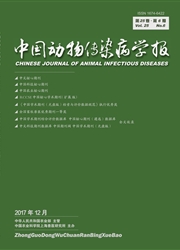

 中文摘要:
中文摘要:
为了分析内化素InlK对单增李斯特菌(Listeria monocytogenes,LM)生物学特性及致病性的影响,利用自杀性质粒进行同源重组构建LM标准菌株10403s的inlK基因缺失株,然后比较分析野生株、inlK基因缺失株的生长特性、生物被膜形成能力、细胞侵袭能力、动物致病力等差异。结果显示,inlK基因缺失不影响LM的生长速度,但可导致LM的生物被膜形成能力下降。细胞感染试验表明基因缺失株ΔinlK对RAW264.7细胞的侵袭及胞内存活能力分别下降了18%和31%。动物感染试验显示野生株和基因缺失株ΔinlK对小鼠的致死率分别为80%(4/5)和40%(2/5),且基因缺失株ΔinlK的体内定殖能力显著低于野生株。本研究表明内化素InlK在LM感染过程中发挥着重要作用,为了解LM的致病作用提供参考。
 英文摘要:
英文摘要:
To determine the biological role of internalin InlK of Listeria monocytogenes(LM), the inlK gene mutant strain ΔinlK was constructed from the virulent strain 10403 s by the homologous recombination technology. The growth curve, biofilm formation, adhesion and invasion capacity to RAW264.7 cells and and pathogenicity in mice of wild-type strain, and mutant strain were determined. The results showed that inactivation of the inlK gene did not affect the growth but the biofilm formation decreased. Moreover, the invasion and intracellular survival capacities of mutant ΔinlK reduced by 18% and 31% as compared with the wild-type strain. In the mouse infection experiment, the mortality rate of wild-type strain and mutant ΔinlK was 80%(4/5) and 40%(2/5), respectively. Moreover, mutant strain ΔinlK displayed significant decreased colonization capacity in mice. These data indicated that internalin InlK was involved in the LMinfection, indicating its contribution to pathogenicity.
 同期刊论文项目
同期刊论文项目
 同项目期刊论文
同项目期刊论文
 Molecular characterization of enterohemorrhagic E. coli O157 isolated from animal fecal and food sam
Molecular characterization of enterohemorrhagic E. coli O157 isolated from animal fecal and food sam 期刊信息
期刊信息
